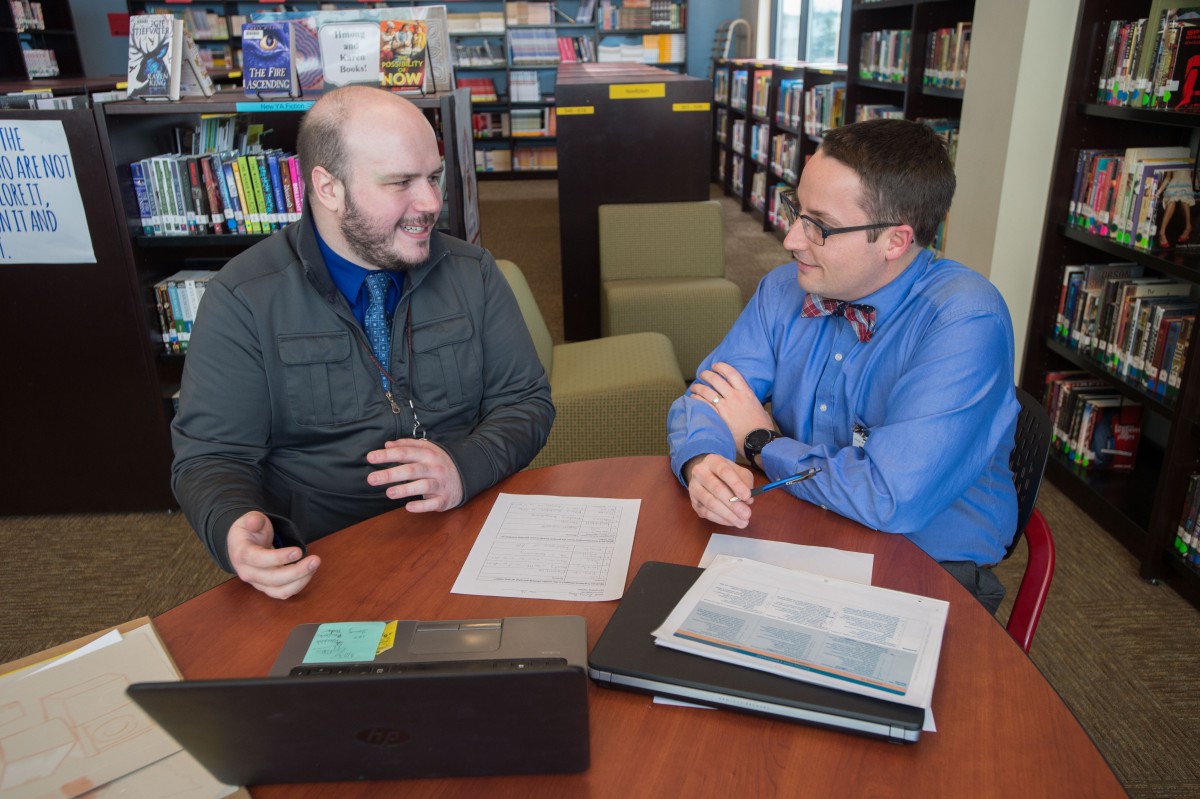How Teacher Leaders Can Help Transform Classroom Instruction Across the Faculty: A Math Example
July 19, 2017

Ryan Lester (right) and colleague Peter Hoks discuss a student-centered approach to conceptual math.
Hmong College Prep in St. Paul, Minnesota, needed to solve the biggest math problem of all: getting students to go beyond the numbers to understand the concepts. TAP's professional development taught teachers and students an equation for success: collaboration + a proven new approach = big dividends for conceptual learning.
Master Teacher and Coach Ryan Lester explains their process.
Four years ago I became the master coach for Hmong College Preparatory Academy's math department. This was a big challenge for me, but has also been rewarding on a number of levels. I’ve gained a deep understanding of the importance of math and how math is not just a series of equations, but also its own art form. (If you have time, read "A Mathematician's Lament" by Paul Lockhart.)
This year has brought the most transformation for the math department and for me in my coaching. Together we have delved into the ideas from "Mathematical Mindsets" by Jo Boaler. This book has challenged our teachers and me to think differently about how to structure math classes and what being a math teacher and math student means.
Before reading this book, our teachers relied heavily on the traditional gradual release model. The teacher shows how to do a problem or two, the class practices how to do the problem together, then the students practice the problems on their own. This method worked for us and our test scores increased.
When digging into our state testing data, my mentor teacher and I saw that our students performed exceptionally well on procedural problems. They could take a problem, put the numbers into a formula, and give you the answer. But they struggled with anything conceptual. While they could take the numbers, plug them in and give you an answer, they had no idea what it meant or why they were doing it.
The ideas presented by Jo Boaler have challenged us to change the way we view teaching and learning in a math class. She argues that math should be taught through inquiry learning by flipping the gradual release upside down. Students should play with math before learning the procedures, students should be presenting their ways of solving meaningful problems, and all students are capable of this type of learning. This way, students first learn the concept and then the procedures behind it. This leads to further motivation in learning math and seeing it as a way of thinking rather than just a series of equations handed down by mathematicians.
The math mentor teacher and I presented these ideas in weekly professional learning "cluster meetings" and teachers slowly bought into these strategies. Because of this work, we are seeing teachers relinquishing control of their classrooms to their students and students starting to engage in meaningful discussions around math. For example, one of our teachers would use 30-45 minutes of class time two or three days per week talking through math problems in "how-to-do-it" mode, and then assigned more problems for more homework. He is changing how he views math teaching and learning, so that now students talk more with each other, present problems to one another, and present alternative approaches and solutions to the same problem. Also, this teacher's homework now emphasizes written student reflection on what they're doing, and having students team up with one another to investigate their questions.
This is a continuous challenge for our students because it is so different from everything they have been conditioned to do through their 6-10 years as math students. Our students that pick up on math topics quickly struggle the most. One of our teachers told me how she was working with students to get them to understand the concept behind the volume of cylinders. One student in particular was struggling to understand why she had to know the concept. While the student could plug the appropriate numbers into the appropriate equation, she struggled to understand and describe the concept behind the equation. The student was accustomed to being given numbers and an equation and putting the two together to get an answer. This was the first time she had been challenged to explain the concept behind the answer.
This is a challenging path, but one that is leading to better discussions and more engagement in math class. As a teacher leader, it is highly rewarding to work with colleagues to move from teacher-centered to more student-centered classrooms.
Ryan Lester served on NIET's educator advisory board during the 2016-17 year.